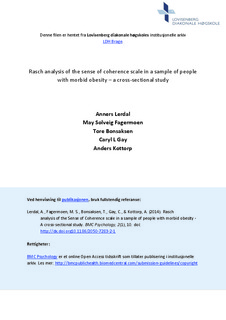| dc.contributor.author | Lerdal, Anners | |
| dc.contributor.author | Fagermoen, May Solveig | |
| dc.contributor.author | Bonsaksen, Tore | |
| dc.contributor.author | Gay, Caryl, L | |
| dc.contributor.author | Kottorp, Anders | |
| dc.date.accessioned | 2016-10-12T08:43:13Z | |
| dc.date.available | 2016-10-12T08:43:13Z | |
| dc.date.issued | 2014-01-21 | |
| dc.identifier.citation | Lerdal, A., Fagermoen, M. S., Bonsaksen, T., Gay, C., & Kottorp, A. (2014). Rasch analysis of the Sense of Coherence scale in a sample of people with morbid obesity - A cross-sectional study. BMC Psychology, 2(1), 10. doi: http://dx.doi.org10.1186/2050-7283-2-1 | nb_NO |
| dc.identifier.issn | 2050-7283 | |
| dc.identifier.uri | http://hdl.handle.net/11250/2414444 | |
| dc.description.abstract | Background: The prevalence of morbid obesity is an increasing health problem in most parts of the world and is related to lower quality of life. Sense of coherence, or the perception that the world is meaningful and predictable, is considered a promising health resource for changing behaviour and adopting a healthier lifestyle. Thus, a valid and reliable instrument for measuring sense of coherence is needed to further research and clinical efforts in this area. The purpose of the study was to examine the psychometric properties of the 13-item Sense of Coherence scale and its sub-dimensions (Comprehensibility, Manageability, and Meaningfulness) in a sample of people with morbid obesity using a Rasch analysis approach.
Methods: Data were collected cross-sectionally in Norway in 2009 from 142 patients ttending a mandatory patient education course for patients with morbid obesity on a waiting list for treatment. Participants completed a socio-demographic questionnaire and the 13-item Sense of Coherence scale at the beginning of the course. Evidence of rating scale functioning, internal scale validity, person-response validity, person-separation reliability and differential item functioning of the 13-item version were explored. The scale’s three sub-dimensions were also evaluated.
Results: A 12-item version of the scale demonstrated the best fit to the Rasch model and increased the variance explained without reducing the separation index. The three sub-dimensions demonstrated good fit but lacked unidimensionality and person-separation reliability. The Meaningfulness sub-dimension showed better psychometric properties than the Comprehensibility and Manageability sub-dimensions.
Conclusion: A 12-item version of the Sense of Coherence scale has better psychometric properties than the original 13-item version among persons with morbid obesity. Further studies should explore whether these questionable validity findings for the 13-item scale generalize to other populations and examine whether including other items from the longer 29-item version may improve the psychometric properties of an abbreviated Sense of Coherence measure.
Keywords: Sense of coherence, Rasch analysis, Psychometrics, Obesity, Health education, Life style, Quality of life, Validity, Reliability | nb_NO |
| dc.language.iso | eng | nb_NO |
| dc.publisher | BioMed Central | nb_NO |
| dc.rights | Attribution-NonCommercial-NoDerivatives 4.0 Internasjonal | * |
| dc.rights.uri | https://creativecommons.org/licenses/by-nc-nd/4.0/ | * |
| dc.subject | Overvekt | nb_NO |
| dc.subject | Kvantitativ forskning | nb_NO |
| dc.title | Rasch analysis of the sense of coherence scale in a sample of people with morbid obesity – a cross-sectional study | nb_NO |
| dc.type | Journal article | nb_NO |
| dc.type | Peer reviewed | nb_NO |
| dc.source.pagenumber | 10 s. | nb_NO |
| dc.source.volume | 2 | nb_NO |
| dc.source.journal | BMC Psychology | nb_NO |
| dc.source.issue | 1 | nb_NO |
| dc.identifier.doi | 10.1186/2050-7283-2-1 | |
| dc.identifier.cristin | 1086993 | |

